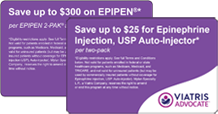
What to expect from patients
In the event an individual experiences anaphylaxis, it is recommended that patients inject EPIPEN® (epinephrine injection, USP) or EPIPEN JR® (epinephrine injection, USP) Auto-Injector or their authorized generics immediately and seek emergency medical attention.1-3 The Patient Information for EPIPEN Auto-Injector (and its authorized generic) recommends that patients take the used Auto-Injector with them to the emergency room for inspection and disposal.1,2 Patients are then instructed to ask for a new prescription and EPIPEN Auto-Injector replacement, if needed.1,2
The continuum of anaphylaxis
The progression of anaphylaxis is not absolute.7 The signs and symptoms can arise within minutes of exposure to an allergen, but can also develop 30 minutes or more after exposure.3,7 Moreover, symptoms that do not initially appear to be life-threatening may progress rapidly unless proper treatment is given.3,7 In some cases, a second allergic reaction occurs 1 to 72 hours (usually within 8 hours) after initial recovery despite no further exposure to the trigger.3,7,8 This is known as a biphasic reaction, and it can occur in up to 20% of all anaphylactic reactions.3,8 Because biphasic reactions are unpredictable (even while administering immunotherapy), it is important that observation periods in the office be individualized for each patient.4,7
Guidelines from the National Institutes of Health and National Institute of Allergy and Infectious Diseases (NIH-NIAID) recommend that patients who were seen in the emergency department for anaphylaxis be discharged with a prescription for epinephrine so that they have access to two doses of epinephrine at all times.5,6
Special Offers
Viatris offers Access and Savings Programs for eligible patients. See Terms and Conditions.
There’s only one recommended first-line treatment for anaphylaxis.
heading
Important Safety Information (the following information applies to both EPIPEN and its Authorized Generic)
EPIPEN (epinephrine injection, USP) 0.3 mg and EPIPEN JR (epinephrine injection, USP) 0.15 mg Auto-Injectors are intended for immediate administration as emergency supportive therapy only and are not intended as a substitute for immediate medical or hospital care. In conjunction with the administration of epinephrine, the patient should seek immediate medical or hospital care. More than two sequential doses of epinephrine should only be administered under direct medical supervision.
Rare cases of serious skin and soft tissue infections have been reported following epinephrine injection.
References
- EPIPEN (epinephrine) injection. Prescribing & Patient Information. 2023. Mylan Specialty L.P. Morgantown WV.
- EPINEPHRINE (epinephrine) injection. Prescribing & Patient Information. 2023. Mylan Specialty L.P. Morgantown.
- Simons FE. Anaphylaxis. J Allergy Clin Immunol. 2010;125(2)(suppl 2):S161-S181.
- Simons FE, Ardusso LR, Bilὸ MB, et al; World Allergy Organization. World Allergy Organization guidelines for the assessment and management of anaphylaxis. World Allergy Organ J. 2011;4(2):13-37.
- Boyce JA, Assa’ad A, Burks AW, et al. Guidelines for the diagnosis and management of food allergy in the United States: report of the NIAID-sponsored expert panel. J Allergy Clin Immunol. 2010;126(6)(suppl):S1-S58.
- Dinakar C. Anaphylaxis in children: current understanding and key issues in diagnosis and treatment. Curr Allergy Asthma Rep. 2012;12(6):641-649.
- Lieberman P, Nicklas RA, Randolph C, et al. Anaphylaxis—a practice parameter update 2015. Ann Allergy Asthma Immunol. 2015;115(5):341-384.
- Sampson HA, Muñoz-Furlong A, Campbell RL, et al. Second symposium on the definition and management of anaphylaxis: summary report—second National Institute of Allergy and Infectious Disease/Food Allergy and Anaphylaxis Network symposium. J Allergy Clin Immunol. 2006;117(2):391-397.

This site is intended for US healthcare professionals.
If you are a patient, please check out our site for patients.

Prescribing Information
Please select from the following:

Patient Information
Please select from the following:



